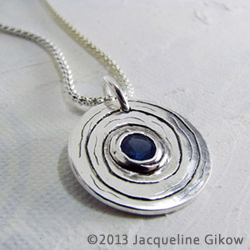Precious Metal Clay For Making Jewelry
by Jacqueline Gikow

A Precious Metal Clay (PMC) pendant.
An interesting material emerged in the late 20th century, called Precious Metal Clay. It sounds like a Medieval fairytale... clay turning into silver (or gold), but the Mitsubishi Materials Corporation of Japan developed a material that feels like fine potter’s clay, that when fired in a kiln, is transformed into pure precious metal. In fact, the metal is combined with the clay from the start. It is suspended in an organic material that burns away when the clay is fired in a kiln. All brands of metal clay come with detailed kiln-firing instructions. There are many different kilns available. For firing any type of metal clay, the kiln has to have the ability to reach and hold the correct temperature for the right amount of time. An item created from PMC will come out from the kiln as a solid metal. Introduced into the United States in 1996, PC is available in either unalloyed fine silver or gold.
Precious Metal Clay (PMC), or Art Clay, depending on the manufacturer, is, in it’s unfired form, a clay made up of microscopic particles of precious metals; silver, gold, or platinum, mixed with a nontoxic organic binding agent and water. In it’s unfired state this clay can be easily molded the same way potter’s clay is. After working the clay, it is fired at a high temperature in an electric kiln where all of the binding agent an water are burned out, leaving only pure metal. Pieces created in PMC result in pure, fine silver or 24k gold.
So who is using PMC? Jewelers, potters, enamellists, miniaturists, children and adults, experienced designers and first-time jewelry makers. Small-scale items are usually created because of the cost of the material. Novices love PMC. People with no metal experience as well as those with a background in clay are often the most excited about PMC.
Before firing, the piece you are making needs to be bone-dry because any moisture left in the clay will immediately turn to steam, which will expand and force its way out of the lay. This can result in blisters, or cracking and a ruined piece, if it breaks.
Kiln Firing Silver Clay for Jewelry
Fine silver metal clay is the easiest to fire because it is pure 999 silver and there aren’t any problems with fire scale. It can be fired on an open shelf in short time. Silver alloy clays should be fired in charcoal to prevent oxidation.
All metal clays shrink during firing. The amount they shrink varies between brands and types of clay. The usual amount of shrinkage is between eight and 12 percent, which is not noticed much in small projects. Thin objects of PMC shrink more than thicker objects. Shrinkage becomes noticeable when you are creating complex pieces or when making jewelry that has to fit a particular size. Flat objects can be placed directly in the kiln, but complex shapes should be laid on a bed of alumina hydrate for support.
Just as with any artistic medium, a financial investment must be made. PMC is not cheap, running around $30 U.S. an ounce. Additionally PMC must be fired in a kiln that can reach up to 1600 degrees. Most kilns, as long as they can reach that temperature, can be used for PMC as well as glass fusing and annealing, lost wax burnout, and enameling. Usually, the larger the kiln the more it costs.
Aside from a kiln, very little in materials are needed. Like other forms of clay, it responds well to hands and fingers. It can be rolled, coiled, pinched, pressed into molds and used on a potter’s wheel. Because it retains surface patterns, an infinite variety of objects can be used to create texture. Some objects, like leaves, can be pressed into the clay and left there. They burn away when fired, leaving behind a detailed imprint.
Related articles
Polymer Clay Basics | Clay Basics | How to Make a Polymer Clay House Necklace | Make a Sterling Silver Roller-Printed Ring
